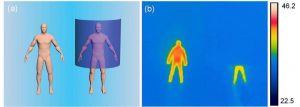The skill of rendering objects undetectable to observers has been a long-lived dream and is a field of science that is rapidly growing. The challenge in making objects completely invisible is to hide all signatures in the electromagnetic spectrum, including visible, microwave, and broadband infrared. Any object with temperatures above absolute zero, such as human bodies and hot parts of vehicles, function as wideband IR sources; therefore, IR detectors can precisely locate them in total darkness and low-visibility conditions. So far, a few solutions including metal amours, thick thermal blankets, and low-emissivity clothing have been suggested to defeat IR detectors. However, they are not efficient and are impractical to use.

Effect of IR stealth sheets on thermal images of a human model. Color bars represent temperature (°C).
In Advanced Engineering Materials, Professor Hongrui Jiang and co-workers present a new concept for infrared stealth using silicon nanowires and silver nanoparticles on a flexible, thin substrate to form metallic-dielectric nanostructures. This technology can be used to produce large sheets that are able to hide macroscopic 3D objects and is compatible with other silicon-based manufacturing techniques. These infrared stealth sheets decrease the amount of infrared energy propagating toward detectors and heat-sensing cameras, making them invisible, and at the same time make use of air channels and arrays of micro-emitters to produce false thermal signatures, achieving a camouflage and disguise function.
The manufacturing technique developed in this study allows for realization of large sheets that can hide macroscopic 3D objects. The researchers conclude that such a breakthrough technology is a significant step toward all-encompassing invisibility technology.
For further reading of the full article, please go here.

















